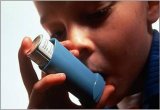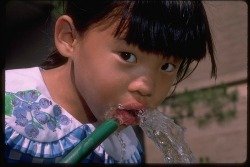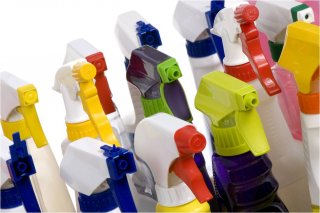Environmental Health Topics in Child Care Facilities for Government Agencies
Below are links to information about environmental health topics of interest to government agencies. These resources can help government agencies:
- Learn about the most up-to-date research on child care environmental health issues.
- Identify key state and regional healthy child care organizations for partnerships.
- See how other states are addressing child care environmental health issues.
On this page:
- Siting Child Care Facilities
- Asthma
- Drinking Water
- Green Cleaning
- Mercury
- Pesticides and Integrated Pest Management (IPM)
Siting Child Care Facilities

Young children are at greater risk than adults from exposure to environmental contaminants. However, most child care centers are not required to conduct an environmental site assessment prior to obtaining a license. Such assessments could help prevent child care centers from operating on sites that could expose children to harmful pollution from neighboring industrial facilities or contamination from past industrial use. This section of the website provides resources to help you identify sources of pollution near your facility.
Resources
Asthma

Asthma is a serious and sometimes life-threatening chronic disease that affects the health and quality of life of 25 million Americans, including seven million children. Poor and minority children are more likely to have asthma and their health outcomes are worse. Black children are twice as likely to be hospitalized and four times as likely to die from asthma as white children.
Allergens and irritants in child care and other indoor settings play a significant role in triggering asthma attacks. The tools in this section provide information on how to reduce children's exposure to common asthma triggers including secondhand smoke, dust mites, molds, cockroaches, and other pests.
Resources
Drinking Water

Young children are at particular risk for exposure to contaminants in drinking water because, pound for pound, they drink more water than adults (including water used to prepare formula), and because their immature body systems are less efficient at detoxification. Exposure to lead in drinking water is a serious health concern, especially for young children and infants since elevated lead levels in children may result in delays in physical or mental development, lower IQ , and even brain damage.
To assist child care centers with implementation of programs and policies to reduce exposure to contaminants, such as lead in drinking water, EPA uses the 3Ts concept: Training, Testing, Telling. The tools in this section provide information on the steps that can be taken to reduce such exposures.
Resources
- Drinking Water Practices for Schools and Child Care Facilities Served by Municipal Water Systems
Green Cleaning

Green cleaning refers to the use of cleaning products that have a reduced impact on human health and the environment, often because they have been re-formulated to eliminate the most potentially toxic ingredients. Child care providers recognize the important role that cleaning, sanitizing, and disinfecting can have in maintaining an attractive, safe, hygienic environment and reducing the spread of germs. But, it is important to know when cleaning is good enough and when sanitization or disinfection, which may involve harsher chemicals, is called for.
And, given the growing set of state requirements promoting green cleaning in early learning environments and schools and increased availability of green cleaning products, it is important for child care providers to know how to identify and use green cleaning products. The following links provide information about the dangers of cleaning products and the steps that can be taken to utilize less toxic alternatives in a childcare setting.
Resources
Mercury

Elemental mercury, a shiny, silver-white metal that is liquid at room temperature, is used in older thermometers, compact fluorescent light bulbs (CFLs), and some electrical switches. Children can be exposed to elemental mercury vapor when products that contain mercury break and expose mercury to the air, particularly in poorly-ventilated spaces.
Mercury can affect the nervous system. Because infants and children are still developing, they are particularly sensitive to the effects of mercury on the nervous system. The following links provide information about the health effects of mercury exposure and steps that can be taken to prevent exposure to mercury in child-care facilities, including what to do when a thermometer or a CFL breaks.
Resources
Pesticides and Integrated Pest Management (IPM)
Exposure to pests such as cockroaches, rodents, ants, and stinging insects in childcare centers may place children at risk for disease, asthma attacks, bites, and stings. Improper use of pesticides can also place children at risk. One study of pesticide use in child care centers revealed that 75% of centers reported at least one pesticide application.
Several factors increase both children's exposures and their vulnerability to these exposures compared to adults. Children spend more time on the floor, where residues can transfer to skin and be absorbed. Young children also frequently place their hands and objects in their mouths, resulting in non-dietary ingestion of pesticides.
Children are less developed immunologically, physiologically, and neurologically, and therefore may be more susceptible to the adverse effects of chemicals and toxins. There is increasing evidence of adverse effects of pesticides on young children, particularly on neurodevelopment. The following links provide information about the health effects associated with exposure to pests and pesticides and the steps that can be taken to use integrated pest management strategies in childcare facilities.
Resources
- Children's Total Exposure to Persistent Pesticides and Other Persistent Organic Pollutants (CTEPP)
- Pesticides in Child Care Initiative: 2010 Staten Island Pilot Project Report (pdf)
- University of California, Berkeley - Center for Children's Environmental Health Research - Pest Management and Pesticide Use in California Child Care Centers(43 pp, 6.2 MB, About PDF)
